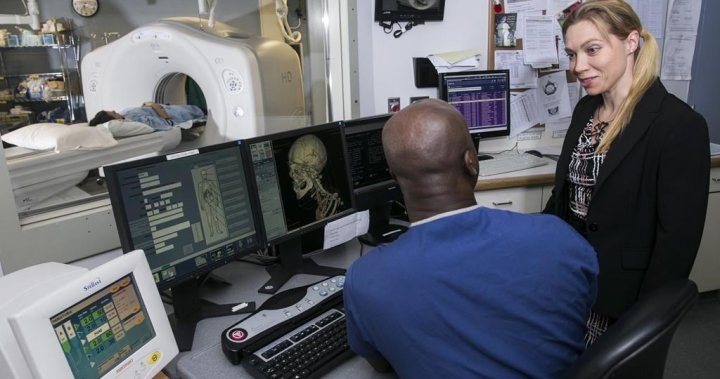Ewa Hodges assumed no news was good news after having a routine mammogram but was later ‘devastated’ to learn that was far from the truth.
The Toronto, Ont., resident discovered a year after her screening in 2019 that she had early-stage breast cancer and needed a lumpectomy.
After her operation, Hodges was told she would have to have follow-up exams at least every six months to make sure she remained cancer-free. But that was just as the COVID-19 pandemic was causing many non-emergency health appointment cancellations.
Read more:
Coronavirus: Doctors concerned about low cancer screening rates in Ontario during pandemic
Hodges got entangled in what she describes as a “frustrating” fight to defend her own health.
“I got a diagnostic phone call that (a follow-up mammogram) was going to be postponed because I’m not considered a priority,” she told Global News.
“That’s how it started. I was calling…everyone was making my head spin.
Two months later her cancer was back and she needed a second lumpectomy.
“I was very lucky because if I had stage one or two or more (stages) I probably would have been dead,” Hodges said.
“I was angry, devastated, not understood. Because everyone was apologizing, including the doctors, but no one is taking responsibility.

Hodges is just one of many Canadians who have been forced to wait longer for a diagnosis due to significant backlogs in diagnostic imaging across the country.
Before the pandemic, wait times for medical imaging were already high, with some patients waiting up to 89 days for an MRI and 82 days for a CT scan, according to the Canadian Association of Radiologists.
The situation has since been further exacerbated, thanks to increased imaging requests after two years of pandemic-related cancellations and postponements, adding to existing imaging backlogs, Dr. Ania Kielar said. , Vice-President of the Canadian Association of Radiologists.
Adding to these pressures is a growing shortage of radiologists in Canada, which means there is more work for a dwindling number of specialists, Kielar said.
“As we’ve heard in the news, with nursing shortages and health care shortages in general, we have the same issues in radiology right now,” Kielar said.
Read more:
“How the hell did this happen? » Over 16,500 mammograms being reviewed across NL
“There is growing pressure to provide effective imaging, but with a limited number of people to do so, … the requests are only piling up.”
Heavy workloads and burnout have led some imaging technologists to retire early, while the number of people entering the radiology field has declined in recent years, she said.
In Canada, 3.6% of medical residency candidates chose diagnostic radiology as their first-choice specialty in 2022, compared to 4.5% in 2010, according to data published by the Canadian Resident Matching Service (CARMS ).
Kielar says Canada is experiencing staff shortages “at all levels” in diagnostic imaging, but in particular, there are shortages in mammography and pediatric radiology.
“Right now, I think the biggest thing is that there’s such a backlog of patients who couldn’t come in during COVID for screening for mammography and cancer in general, that the load of work has just exceeded what we are capable of handling. ”
Read more:
Code Blue: A global news series delving into Canada’s health care crisis
The end result is that patients are forced into a bottleneck, where they are forced to wait longer for information from CT scans, mammograms and MRIs – information needed to receive additional treatment for certain serious conditions, Kielar said.
“A surgeon cannot operate if he does not know what he is operating. An oncologist cannot give more chemotherapy unless he knows for sure that the therapy he is giving at that time is actually working,” she said.
“Thus, by having to wait longer, patients’ illnesses go untreated longer, which can have negative consequences for them in the long term and prolong the duration of their illness.”
Read more:
Nearly 30% of Canadians report ‘chronic difficulties’ accessing health care: Poll
In March, the federal government pledged $2 billion to provinces and territories to address medical backlogs resulting from the COVID-19 pandemic, including in diagnostics.
Kielar says this is a much-needed investment, but stressed the need to distribute it equitably among key areas of need across Canada and to be transparent about how this money is allocated.

Canada also needs to do more to attract and retain imaging technologists, including adding more radiology residency spots for students, Kielar said.
In a statement to Global News, Health Canada says provinces and territories took a series of steps to increase health system capacity early in the pandemic in anticipation of potential increases in demand for health services, including by postponing certain elective surgeries and medical procedures such as as a diagnosis.
Read more:
Ottawa pledges $2 billion for pandemic surgery delays, warns universal health care ‘at risk’
“As provinces and territories continue to protect capacity for patients with COVID-19, most have resumed the majority of regular services and are making progress against backlogs built up in the early weeks of the pandemic,” said Health Canada. .
The federal health agency also pointed out that $19 billion has been allocated under the “safe restart agreement” with the provinces to help them reopen their economies, and that part of this funding is “used by some provinces/territories to address backlogs and reduce waits to worry about.” He further noted that the training of diagnostic imaging technicians — like the management of all health professionals — is a responsibility provincial.
Specific questions about March’s $2 billion federal commitment — whether that money has already been distributed to provinces and how much has been specifically allocated to address imaging delays — were not addressed by Health Canada in its statement.
© 2022 Global News, a division of Corus Entertainment Inc.

“Travel aficionado. Twitter scholar. Writer. Extreme coffee guru. Evil pop culture fanatic.”
